Location: Dollars → Morgan Dollars
Morgan Dollars
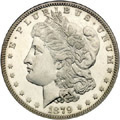
There are few relics, like the Morgan Silver Dollar, that show us a glimpse into our past as an evolving country. The Morgan Silver Dollar was successfully minted from 1878 to 1904 and again for one more year in 1921. Throughout its 27 years of production, two famous mints closed their doors, three bills were passed to approve the minting of silver dollars, and the Denver Mint was established and currently stands as the world leader of coin production. The Morgan Silver Dollar has a fineness of .900, and weighs a total silver content of 0.77344 troy ounces per coin. After 130 years of being minted, the Morgan Silver Dollar is still among the most popular coins sold in the country and is also advised as a smart investment, due to its low mintage averages and 90% silver content.
The Design of the Morgan Silver Dollar
George T. Morgan was the English engraver for the United States mint, who is responsible for designing some very famous coins. Morgan was an assistant engraver for 30 years before he was announced the Chief Engraver for the United States Mint. Having a coin named after you is the upmost honor for an inspiring engraver. Morgan's design accentuates Lady Liberty at a very up close angle. On other coins in circulation, the Lady Liberty is shown from head to toe, her slender body in full view. But Morgan's take was of her beautiful face and at a side angle, he respectively portrays her features as delicate and lovely. An eagle is on the reverse of the Morgan, with outstretched wings and unique tail feathers. The beloved saying, "In God We Trust," is also included, like all other US currency.
The Five Mints that Produced Morgan Silver Dollars
The Philadelphia Mint
The Philadelphia Mint is the first mint to ever be built in the US. The Founding Fathers realized that the US needed a place to produce coinage to establish a national identity and a means of commerce among citizens. The Coinage Act of 1792 was added into law on April 2, declaring the Philadelphia Mint's importance to the country. At the time, Philadelphia was the capital of the US so it only made sense for it to host the inaugural US Mint. The Coinage Act of 1792 also provided a decimal system for US coinage to abide by and one of the demands was that every US coin should contain "an impression emblematic of liberty." David Rittenhouse was a scientist, who was appointed by George Washington, as the first mint director of the US. The Philadelphia Mint did not place a mint-mark on their coins until recently. An easy way to decipher, if a coin was minted at the first mint, is if it has no mint-mark or, for recent coins, it carries a "P."
The San Francisco Mint
Opened in 1854, the San Francisco Mint still stands today as the second oldest operating mint in the US. Initially, the San Francisco Mint was opened, due to the California Gold Rush, to provide a place for prospectors to turn in their gold for actual coinage. In just its first year of production, the San Francisco Mint turned $4 billion of gold into coins. The San Francisco Mint carries a couple of endearing nicknames, such as the Old United States Mint or the Granite Lady (even though the building is actually made from sandstone). The San Francisco Mint withstood the Earthquake of 1906 and was able to maintain production until it moved to its current facility, in 1937. Nowadays, the San Francisco Mint produces mostly proof coinage, such as the US Proof Sets. The San Francisco Mint's signature is a "S" mint-mark.
The New Orleans Mint
The New Orleans Mint first opened in 1838-1861. Then, it reopened in 1879-1909 since it was closed during the American Civil War and the Reconstruction period. In its prime, it produced 427 million gold and silver coins of every US denomination. The New Orleans Mint was decommissioned in 1909 but the state wanted to keep the building so it has been used for several unrelated purposes, such as a fallout shelter, US Coast Guard storage facility, and an assay office. Since 1981, it has served as a branch of the Louisiana State Museum and is now considered a National Historic Landmark; being the oldest surviving structure of a US Mint. The New Orleans Mint stamped all of their coins with an "O" mint-mark.
The Carson City Mint
The Carson City Mint was built at the peak of silver mining and was conveniently located near a popular silver mine. Based in Nevada, the Carson City Mint was built in 1863 but didn't begin operating until 1870, when it minted mainly silver coins. It operated for 15 years, took a break and picked back up in 1889. Finally, in 1893, the Carson City Mint closed its doors as a US Mint branch and now is the Nevada State Museum. The Carson City Mint used the "CC" mint-mark on all of its coins.
The Denver Mint
Only established in 1906, which is considered young for the almost 200 year old mints, the Denver Mint mainly produced commemoratives or mint sets. Coin collectors will see the "D" mint-mark from time to time, on silver coins, because the Denver Mint had to aid in fulfilling the requirements of the Pittman Act. Often viewed as the underdog in its earlier days, the Denver Mint has now earned the name of the largest producer of coins in the world!
Certified Morgans
Since Morgan Silver Dollars can come in a variety of conditions, collectors often relay on certified Morgan Silver Dollars to know the exact grade of the coin. As most coin collectors and numismatists know, a coin can widely range from being considered good condition all the way up to brilliant uncirculated or proof, but that's just the beginning of identifying a coin's value. Dr. William Sheldon was an American psychologist by trade and a numismatist as a hobby. In 1948, Sheldon developed the Sheldon Numeric Scale, which became the foundation of grading and certifying coins. The Sheldon Numeric Scale dictates that a coin's condition can fall between 1 and 70. Before this groundbreaking system, coins were graded mostly by physical appearance and could receive one of three grades.
There are many coin grading agencies out there but only two that are revered worldwide. The Numismatic Guaranty Corporation (NGC) and the Professional Coin Grading Service (PCGS) are two companies that issue coins their grades. These companies not only certify coins, but they also encase the graded coin into an official holder, preserving the coin and marking the holder with its earned grade. This alone has changed the coin collecting game, while also offering a peace of mind for collectors and investors.
When purchasing a Certified Morgan Silver Dollar, there is information provided on the coin holder that is important to know. The first thing to notice is the coin's strike type:
- MS: Short for "Mint-State;" refers to coins that have never been in circulation and are the same condition as when they were originally produced. Mint State coins will receive a grade ranging from 60-70 on the Sheldon Numeric Scale.
- PF/PR: Abbreviation for "Proof;" refers to the method of coin manufacture, made for eye appeal among collectors.
Many Morgan Silver Dollars were put into circulation and cannot receive MS grades. The Sheldon Numeric Scale begins at Good condition, wherein its grade would range from G1-G10, etc.
Morgan Silver Dollar Varieties
For Morgan Silver Dollars, depending on the date of mintage and mint-mark can greatly determine the ease of finding a brilliant uncirculated coin. There are also different varieties, i.e. production mistakes that can make a coin more desirable. A few examples of these "mistakes turned into profit" are:
- Since 1878 was the initial year for the Morgan's production, they had a lot to work out, in order to mint the perfect silver dollar. The 1878 7tf rev 78 Morgan Silver Dollar exhibits an eagle with 7 tail feathers but its chest isn't proportionate to its body. The eagle, on the reverse, exhibits a small, sunken-in chest that isn't a realistic portrayal of the powerful bird the US is so proud of. In 1879, the US Mint corrected the problem and gave the eagle a more robust chest. These Morgans, that were the pioneers of the famous silver dollar, are held at a high esteem in the coin collecting world.
- The 1878 7tf rev 79 Morgan Silver Dollar is a rarity that is included on every collector's bucket list. The reverse eagle, in 1878, featured a flat, sunken chest that wasn't copesthetic with what a real eagle looked like. That reverse design was updated with a more pronounced, robust chest in 1879. The US Mint went back over some of the 1878 Morgans to refine the eagle's chest and that is how the 1878 7tf rev 79 Morgan was born. This Morgan also features the original tail feather amount of 7, instead of the 8 that would stick after 1879.
- The 1878 8tf Morgan Silver Dollar is among the list of endearing mistakes that the US Mint in the first year of the Morgan's production and is a key coin to any Morgan collection. Traditionally, there are 7 tail feathers that are visible but the way the die minted the coin, an extra tail feather became noticeable. The 1878 8tf was a common error on the US Mint's part, adding another feather to the eagle's tail feathers. The Morgans that showcase a mistake have become an example of when a mistake is actually rewarded. Little did the US Mint know that these mishaps would increase the overall numismatic value of the Morgan.
There are also coins that were hoarded for decades then reclaimed once the owner passed away. The Redfield collection is known among collectors since thousands of Morgan Silver Dollars were found after LeVere Redfield died. In this hoarded collection, many variety coins were recovered, certified, and sold into the market.
GSA Morgan Silver Dollars
Caches of Morgan Dollars produced at the Carson City Mint were discovered and were sold to coin collectors by the federal government in the early 1970s. Many of these dollars were uncirculated and are called GSAs (named after the General Services Administration) and come in black plastic holders that mimic the holders used for proof silver Eisenhower dollars of the period. These have become collectible items within the GSA encapsulation.
-
 Morgan Silver Dollar Low Grade Better Dates
Low Grade Key Date Coins
Morgan Silver Dollar Low Grade Better Dates
Low Grade Key Date Coins
-
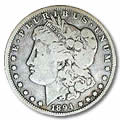 Morgan Silver Dollars Good-Very-Good Condition
Morgan Silver Dollars Good-Very-Good Condition
-
 Morgan Silver Dollars Fine Condition
Morgan Silver Dollars Fine Condition
-
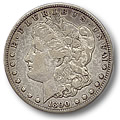 Morgan Silver Dollars Very Fine Condition
Morgan Silver Dollars Very Fine Condition
-
 Morgan Silver Dollars Extra Fine Condition
Morgan Silver Dollars Extra Fine Condition
-
 Morgan Silver Dollars Almost Uncirculated Condition
Morgan Silver Dollars Almost Uncirculated Condition
-
 Morgan Silver Dollars Brilliant Uncirculated Condition
Morgan Silver Dollars Brilliant Uncirculated Condition
-
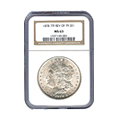 Certified Morgan Silver Dollars
Certified Morgan Silver Dollars
-
 Certified Toned Morgan Silver Dollars
Certified Toned Morgan Silver Dollars
-
 Morgan Dollar Varieties (VAMS)
Morgan Dollar Varieties (VAMS)
-
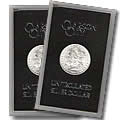 GSA Carson City Morgan Dollars
Original Box and Certificate
GSA Carson City Morgan Dollars
Original Box and Certificate
-
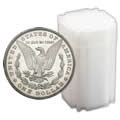 Morgan Dollar Rolls By Date
Morgan Dollar Rolls By Date







